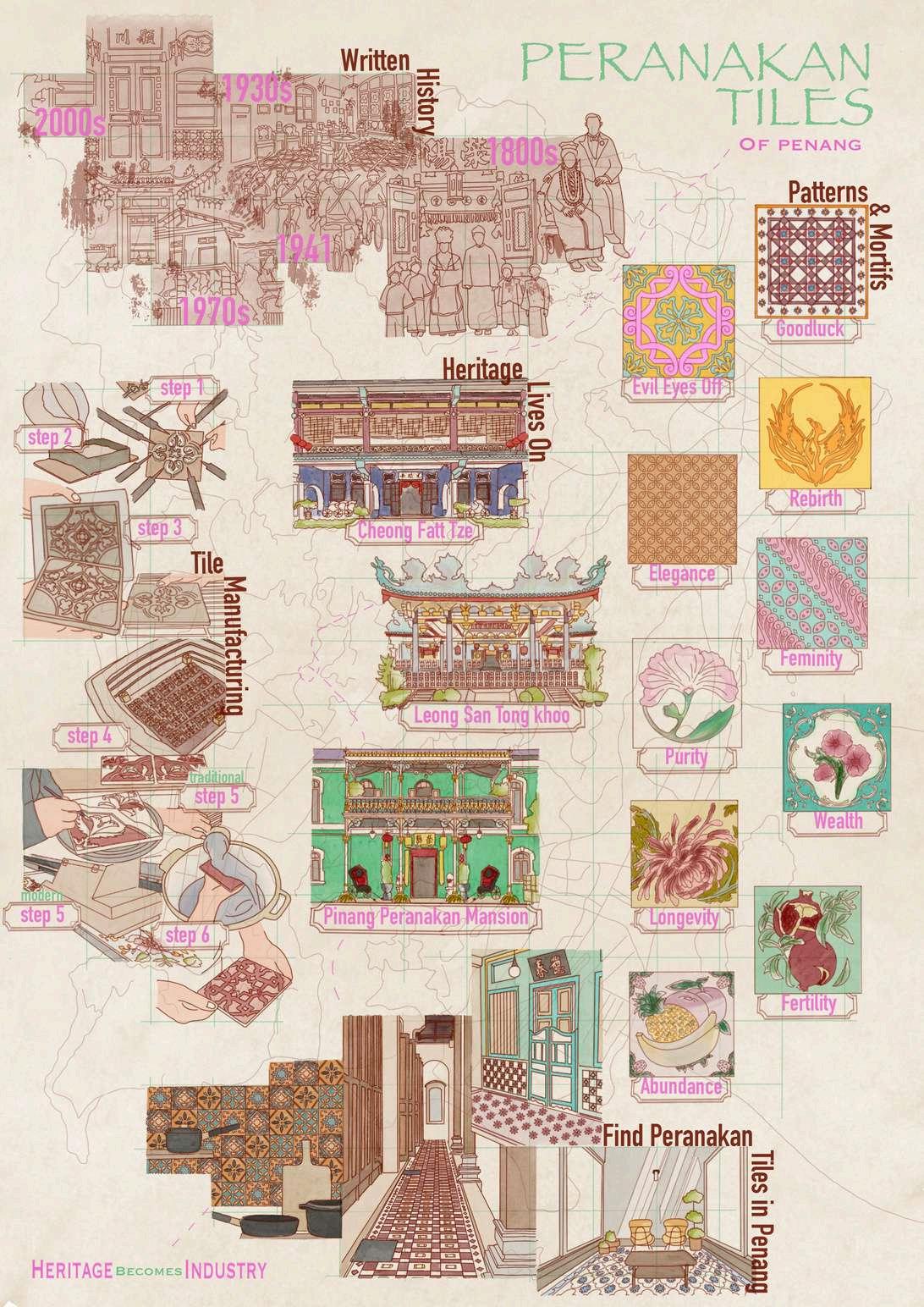Curating an Abstract – The Narrative

Narrative Board
Researchand conceptualizeideaof Penang’slegacyPeranakanTile Industry


Narrative Board
Improvised narrativeboard



Researchand conceptualizeideaof Penang’slegacyPeranakanTile Industry


Improvised narrativeboard

Phase I was an eye-opening journey into the heritage of Penang, where I chose to explore the Peranakan tile industry. Through extensive research, I discovered how these tiles are more than decorative elements they carry stories, cultural identity, and symbolism in every pattern and motif. My narrative board traced theirorigins,theinfluenceofPeranakancultureinPenang,andthe evolution of production from traditional handcrafting to modern manufacturingtechniques.IalsomappedkeylocationsinPenang whereauthenticPeranakantilescanstillbefound,understanding howtheyhavebeenpreservedandadaptedovertime.
This process deepened my appreciation for how an object as simple as a tile can hold historical significance and serve as a bridge between art, craft, and community identity. Curating the board challenged me to present research visually and narratively, ensuring it was both informative and engaging. It also sparked ideasonhowthisheritageelementcouldmeaningfullyconnectto my escapade concept for the final project, reinforcing the importanceofculturalstorytellingindesign.
Visitedthesitetoobserveanddocumentkey physicalelements.Recordedthesite'ssize, materials,existingconditions,andanyhistorical contextavailable.Tooknoteofthesurrounding environment,includingnearbybuildings,traffic flow,accesspoints,anduserbehavior
DocumentedallindividualnarrativeofObserve, Collect,Analyze,Compare,NoticeandPattern-on VisualJournal.




Phase II was an immersive, hands-on experience that allowed me todirectlyengagewiththeheritagesettingofArmenianStreetand the Sun Yat Sen Museum in Penang. Over three days, our group exploredanddocumentedkeyarchitecturalandculturalelements, butmyindividualfocuswasondoors,windows,airvents,five-foot walkways, and tile patterns. I carefully photographed, sketched, and recorded measurements, noting materiality, craftsmanship, and signs of wear that revealed the age and character of each element.
Beyond the building itself, I observed how the surrounding environment trafficflow,pedestrianmovement,andneighboring structures—interacted with the site. This helped me understand the relationship between heritage architecture and its urban context. The Visual Journal became my personal record of this journey, using the “Observe, Collect, Analyze, Compare, Notice, andPattern”frameworktocapturenotjustthephysicaldetailsbut alsorecurringdesignmotifsandculturalinfluences.
Contributing my findings enriched our group narrative and enhanced my ability to analyze and adapt heritage details into futuredesigns.










GlazeFatesisaboutiqueescapadehotelinspiredbythelivinglegacyofthePeranakan tile industryinPenang asanctuarywherenostalgia, jade-tonedcalm,andsacred symbolismunfoldthroughcraftedspace.Rootedinthegeometriclatticemotifsof traditionaltiles,believedtobringgoodluckandprotectagainsttheevileye,thehotel invitesgueststoexplorenotonlydesign,butdestiny.ThejourneybeginsinEmberHall, whereearthytonesandsoftlightsettheatmosphereofwarmthandquietritual.From there,theMotifWalkguidesguestsupward—aninteractiveinstallationrevealingthe meaningsandtexturesbehindPeranakantilework.Attheheartofthehotelliesthe Glazer’sLab,ahands-onspacewhereguestspaintandfiretheirowntiles,creating personalmemoriessealedinglaze.Upstairs,theMotifWalkleadstosignaturerooms— Peony,Nyonya,andLotus eachoneechoingheritagethroughpatternandmaterial. ThestorycontinuesattheTileAbacusandTilesofTrade,wheretouchandnarrative bringthepasttolife.Groundedincomfort,guestsdineattheArtisan’sDining,sipinthe TehCorner,andunwindacrossthePorcelainPatioandTilesofWell acourtyardoasis ofwater,sky,andserenity.GlazeFatesisnotjustastay.Itisafatedpause—firedin story,wrappedinsymbol.


Exploded Axonomentric




Tiles of Well




















The Final Project, Glaze Fates, was an exciting opportunity to translate the Peranakan tile industry’s heritage into a residential hotel space that blends tradition with modern comfort. Drawing frommyPhaseIresearch,Iaimedtopreservetheculturalrichness of Peranakan motifs while integrating contemporary design elements to appeal to today’s travellers. This process deepened my understanding of how heritage can be embedded into spatial storytelling,creatingastaythatisbothimmersiveandmeaningful.
Designing Glaze Fates also strengthened my technical skills, particularly in orthographic drawings and renderings, as I worked to convey both atmosphere and precision. My research guided spatial planning and material selection, ensuring each area — remained authentic to Penang’s identity while offering guests unique,hands-onexperiences.
This project gave me a glimpse into real-world design workflows, balancingcreativitywithfunctionalandculturalconsiderations.It pushed me to think critically about how design can preserve historywhileofferingsomethingfreshandmemorable,leavingme moreconfidentanddetail-focusedasadesigner.